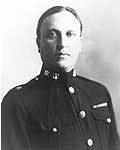Years of service 1898 - 1937 | Name David Porter Rank Major general | |
 | ||
Born April 29, 1877Washington, D.C. ( 1877-04-29 ) Allegiance United States of America Battles/wars Philippine-American WarWorld War I Battles and wars | ||
Major General David Dixon Porter (April 29, 1877 – February 25, 1944), a Medal of Honor recipient, was a United States Marine Corps officer who served in the Philippine-American War and in World War I.
Contents
Biography
He was the son of Lieutenant Colonel Carlile Patterson Porter (1846–1914), USMC, grandson of Admiral David Dixon Porter (1813–1891), and great-grandson of Commodore David Porter (1780–1843).
Captain Porter received the Medal of Honor during the Philippine-American War for efforts in battle at the junction of the Cadacan and Sohoton Rivers, Samar on November 17, 1901. He was also one of the Officers who participated in Waller's march across Samar.
Porter retired from the Marine Corps after World War I and was promoted to Major General on the retired list.
He is buried in Arlington National Cemetery Arlington, Virginia. His grave can be found in section 2, lot 3479.
Medal of Honor citation
For extraordinary heroism and eminent and conspicuous conduct in battle at the junction of the Cadacan and Sohoton Rivers, Samar, P. I., November 17, 1901.
Citation:
In command of the columns upon their uniting ashore in the Sohoton Region, Col. Porter (then Capt.) made a surprise attack on the fortified cliffs and completely routed the enemy, killing 30 and capturing and destroying the powder magazine, 40 lantacas (guns), rice, food and cuartels. Due to his courage, intelligence, discrimination and zeal, he successfully led his men up the cliffs by means of bamboo ladders to a height of 200 feet. The cliffs were of soft stone of volcanic origin, in the nature of pumice and were honeycombed with caves. Tons of rocks were suspended in platforms held in position by vines and cables (known as bejuco) in readiness to be precipitated upon people below. After driving the insurgents from their position which was almost impregnable, being covered with numerous trails lined with poisoned spears, pits, etc., Col. Porter led his men across the river, scaled the cliffs on the opposite side, and destroyed the camps there. He and the men under his command overcame incredible difficulties and dangers in destroying positions which, according to reports from old prisoners, had taken 3 years to perfect, were held as a final rallying post, and were never before penetrated by white troops. Col. Porter also rendered distinguished public service in the presence of the enemy at Quinapundan River, Samar, Philippine Islands, on 26 October 1901.
Marine Corps Brevet Medal citation
Citation
The Secretary of the Navy takes pleasure in transmitting to First Lieutenant David Dixon Porter, United States Marine Corps, the Brevet Medal which is awarded in accordance with Marine Corps Order No. 26 (1921), for distinguished conduct and public service in the presence of the enemy while serving with the Second Battalion of Marines, at Novaleta, Philippine Islands, on 8 October 1899. On 28 March 1901, First Lieutenant Porter is appointed Captain, by brevet, to rank from 8 October 1899.
